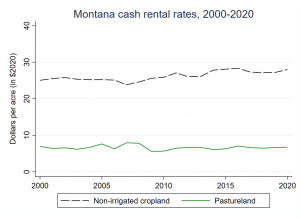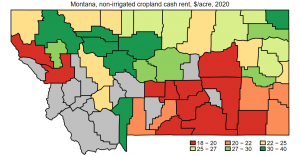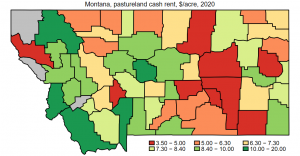Land in farms is either owner-operated (i.e., owned by the farm operator) or rented, with rented land coming from another farm operator or a landowner not actively involved in farming. The farmland tenancy rate measures the percentage of land in farms that is rented. Based on the 2017 Census of Agriculture, the tenancy rate in Montana is 31% (representing 18 million rented acres), which compares with a U.S. aggregate rate of 40%. Part of the difference between the Montana and US tenancy rates partly stems from the fact that a large share of Montana’s farmland is in pasture/range use, which is rented out less often than cropland. Thus, relatively cropland-heavy states tend to have much higher tenancy rates than Montana. For example, Illinois’s 2017 statewide tenancy rate is 58%.
Most rented land is leased out under a cash agreement, where the tenant pays the farmer an annual rent, typically through a one-year contract that may then be renegotiated each year. Although cash rents are often discussed in conjunction with farmland values, it is important to keep straight what each does and does not measure. Farmland values represent the discounted stream of future income accruing to the landowner, from both farm and future non-farm uses. Cash rents, on the other hand, are more closely linked to the current net income from farming the land, and can be thought of as the typical residual income earned by the tenant after accounting for normal production-related operating expenses.
The USDA collects and publishes information on cash rents each year. For Montana, the 2020 survey data report cash rent levels of $34/acre for cropland and $6.70/acre for pastureland. Breaking the cropland rents down, non-irrigated cropland is rented out for an average of $28/acre, while irrigated land, which tends to command a high premium, has a current rental rate of $85/acre. The fact that the average cropland rental rate is so much closer to the non-irrigated rate indicates that the majority of Montana’s rented cropland tends to be non-irrigated. For the remainder of the post, when discussing cropland I will focus only on non-irrigated land.
After adjusting for inflation, non-irrigated cropland and pastureland cash rental rates have more or less held constant over the past 20 years. Cropland rents have exhibited a modest upward trend, from $25.06/acre in 2000 to the current level of $28/acre. The low point for cropland rent occurred in 2007 ($23.85/acre), while the 20-year high occurred in 2016 ($28.35/acre). Over the past year, cropland rents increased by $0.80/acre. Pasture rents, on the other hand, have come down slightly in recent years, with a 20-year high of $7.95/acre occurring in 2007 and the low point of $5.60/acre being found in 2009. Current pasture rents are $0.05 higher than they were a year ago and only $0.25 lower than they were in 2000.

Since 2008, the USDA. has also produced annual county-level estimates of cash rents. The map below plots the non-irrigated cropland cash rents for 2020. Note that the greyed-out areas represent counties without sufficient information to show a cash rent value for 2020. Cropland rents tend to be highest, in the range of $30-40/acre in the north central/northwestern part of the state (and Gallatin County) and tend to be a bit lower in the south-central southwestern part of the state. The highest per-acre rents for 2020 are found in the following counties: Gallatin ($40/acre), Cascade ($38), Flathead ($37), Pondera ($36), and Teton ($35). The highest observed county cropland rental rate is more than double the lowest ($18) found in Powder River and Yellowstone Counties.

The second map shows county-level pastureland rents for 2020. High pastureland rents tend to be found in the western half of the state, along with a small handful of counties in the east. The following five counties had the highest pastureland rents in 2020: Flathead ($20/acre), Beaverhead ($13.5), Ravalli ($13), Gallatin ($13), and Judith Basin ($11). Although pasture rents tend to be lower, on average, the range of average pasture rents across counties is substantial, with the highest average rent being more than five times the lowest ($3.50; Sanders County). One limitation of the cash rents data for pastureland is that they do not account for land rented out on a per-AUM basis, as is the case on the public land that many ranchers in Montana lease from the Bureau of Land Management and U.S. Forest Service.

Cash rental rates are affected by a variety of factors, including weather, commodity prices, recent crop yields, other operating expenses, contract renewal terms (i.e., annual versus multi-year leases), and landlord-tenant relationships. Government payments have also been shown to affect rental rates. In recent years, the Coronavirus Food Assistance Program and Market Facilitation Program are thought to have kept rents afloat. To this end, it will be important to monitor whether additional rounds of ad hoc aid to the agricultural sector may be forthcoming in 2021.

